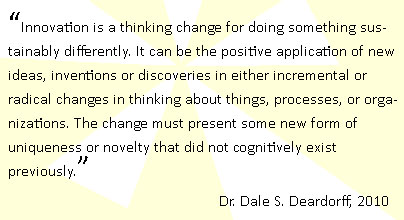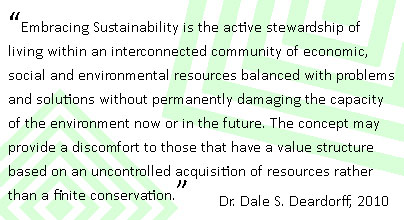|
Leading Project Management Efficiency & Effectiveness with Simulations, Personal and Organizational Knowledge

Project Management is one of the most challenging activities that a Leader will face in their career. It is a personal and professional journey focused on creating and optimizing efficiency and effectiveness while working with the heart of the organization’s resources. This requires the balancing of risks & opportunities against evolving and dynamic daily challenges. Project Management can also be a roller-coaster ride of changing activities that test your experience, skills and passion. On a bad day, it tests your sanity, stamina, and patience; and ultimately will determine if a project is considered a success or a failure.
The two primary objectives of Project Management are that a project should be completed “on time”, and within the “baseline” budget. To accomplish this, requires that Project Managers lead others to follow processes allowing their organizations and people to be effective and efficient. Most projects challenge effectiveness and efficiency by creating a continuous gauntlet of changing scenarios and dynamic personnel situations which seem to always be moving in the wrong direction. Sometimes in an effort to help create a more efficient task we may find we are ignoring effectiveness, resulting in a project breakdown. The principles of project effectiveness and efficiency may create an organizational contradiction requiring a balancing act that can seem to create a lose-lose position.
The quick definition of Project Management Efficiency is a measurement of the ability to get the right project team to perform project tasks and to close the project successfully within the agreed constraints.
Project Management Effectiveness measures the appropriateness of the goals that an organization is pursuing while applying knowledge, tools and techniques to achieve the project goals.
To create a winning position, requires utilizing all of the Project Management tools at your disposal including some you may not have heard of previously. Additionally, it mandates adherence to a multi-dimensional PM philosophy and mindset. This mindset requires a balance of skills and training that require personal, professional and organizational PM knowledge. These principles of effective Project Management are applicable to any project type across different industries, but project-driven environments like construction and aerospace typically need more rigorous Project Management guidance.
The development of Project Management standardized processes and procedures are still at the center of discussion about industry training. The Project Management Body of Knowledge (PMBOK) and Projects in Controlled Environments (PRINCE) are two of the most widely used standards applicable to any nature of project in any industry. At the same time, there is still a need to understand the unique difference between efficiency and effectiveness in project execution and completion.
 Organizational Efficiency & Effectiveness Organizational Efficiency & Effectiveness
Organizations have to be both effective and efficient in order to be successful. To distinguish between effectiveness and efficiency, a brief definition should help.
- Organizational Efficiency is “doing things right” - Working smartly in each project step to do the job as well as possible creating high quality output.
- Organizational Effectiveness is “doing the right thing” - Working with a process structure to meet the overall project goals and milestones.
These simple definitions point to a clear distinction that has major implications for projects of all sizes. The implications arise from the difficulty in balancing both efficiency and effectiveness. In order to maximize your efficiency you need a method for prioritizing and arranging both your inputs and outputs. Proper assessment and organization of the inputs leads to a greater effectiveness, while proper organization of the output leads to greater efficiency. This is a method called “Planning”. It is possible to increase and optimize efficiency to the point where you cannot be effective and vice versa.
Project Efficiency
Efficiency measures how well Project Managers use their resources to achieve goals. Project Management places a heavy focus on how to acquire the right project team formation to perform project tasks and to close projects successfully within the agreed constraints.
In “Resource” planning, the Project Manager proactively boosts efficiency by deciding on the Organizational Structure, Roles, and Responsibilities to complete specific project tasks. Later, when the PM acquires the project team, he or she obtains the right human resources according to the Roles and Responsibilities, and then decides on any training needed to complete the tasks. The Project Manager should keep an eye on the assigned resources available to understand if they are over or under allocated, as seen in the figure below.
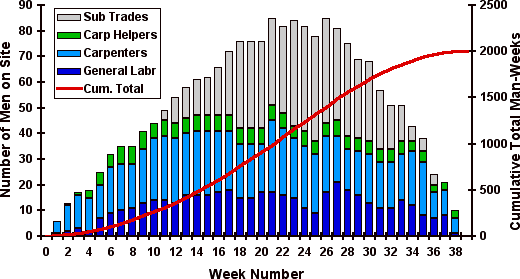
Sample Resource Usage Curve
The Loaded Resource Usage Curve seen above needs to be smoothed by the use of resource leveling. A resource leveling tool is used to increase efficiency by eliminating over allocation of your resources and keeping almost constant or smooth use of resources throughout the span of the project lifecycle. When it comes to the “Monitoring & Controlling” phase, the Project Manager tries to increase efficiency by resolving any negative conflicts that may occur in the project team while reviewing the team’s performance leading to the increase in the overall performance of the project.
The “Efficiency” of a project is a simple ratio of the outputs from a process activity in relation to the project resource inputs. A numerical representation of the project output achieved for the project input is used. This project can then be described as efficient only if all stages of project execution, project delivery and implementation are completed within the constraints identified in the project scope in terms of workforce, cost, time and the milestone objectives.
If a project is able to optimize its resources to the fullest by eliminating any unnecessary idle time, while preventing delays or reducing wasted time in the project activities you are considered efficient. Saving time, money or effort by getting the maximum output with minimum resources is a primary indicator of a project's efficiency. Efficiency and Effectiveness are both commonly used management terms and while they sound very similar they are a contradiction and both mean distinctively different things as seen in the figure below.
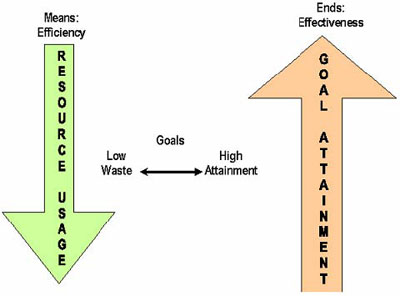
Efficiency versus Effectiveness Contradiction
Project Management is primarily concerned with productivity. When a Project Manager disregards the “means” for how to get tasks done or does the wrong tasks they may get the job done, but at a tremendous cost to the project. They are ultimately very inefficient. If you panic and crash a project by putting all of the resources on one specific task you usually become inefficient and typically lose your overall planned schedule.
Can a Project Manager be Efficient but not Effective? – YES, by doing the wrong tasks well. Specific examples of this are; working tasks that are “out of scope” or not included in the customer’s requirements. Additionally “gold plating” a task leads to giving the customer more than they originally asked for. Most of the time, these are done without the Project Manager’s knowledge.
Project Effectiveness:
Effectiveness is concerned with “doing the right things.” Bringing a balance between efficiency and effectiveness is one of the critical jobs of any Project Manager. This balance must be concerned with the existing organizational system structures and processes. Key Performance Indicators (KPI’s) are crucial to accurately measure functional performance for addressing key issues and the overall behavior of a project. Utilizing KPI’s effectively provides a gauge of Project Management disciplines against your project performance. Each project is defined as “unique” so it may require a customized series of KPI’s but, as a minimum must provide indication of the following 8 effectiveness measurements:
- Does the project manager have a well-defined scope and are they tracking progress against it?
- Is the project manager aligned with achieving the project objectives?
- Does the project manager have a well-defined budget and are they tracking accurate and realistic expenditure against it?
- Does the project manager have a clear set of goals and milestones to meet the project requirements?
- Is the project manager involved in the project work and know what’s going on at the right times?
- Does the project manager support the project team by identifying and resolving risks or issues quickly?
- Is the project manager communicating clearly, openly and honestly?
- Does the project manager raise issues they can’t resolve and ask for help when needed?
Effectiveness measures the appropriateness of the goals that an organization is pursuing and the degree of achieving these goals. Project Management effectiveness is clearly about applying knowledge, tools and techniques to achieve project goals measured by accountable performance.
With the pressure to constantly be as efficient as possible, an organization can get caught up in focusing too much on reducing process time and/or the number of employees and not enough on what makes sense for the organization. Doing the right thing is often overshadowed by doing things right. Effectiveness refers to doing the right things. It constantly measures if the actual output meets the desired output.
Effectiveness takes into consideration any variables that may change in the future and encourages innovation requiring people to think and consider the different ways they can meet the desired goal. A way to dramatically increase both Project Management efficiency and effectiveness is simulation or scenario based training.
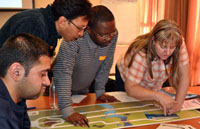 Project Management Simulations Project Management Simulations
So now that we clearly understand the typical challenges in Project Management and the philosophy of balancing effectiveness (performance) & efficiency (process), the discussion shifts to skills integration. So we must ask ourselves “How can we improve our ability to optimize project success?” A simple and viable opportunity to increase and fine tune project successes is to engage in basic or advanced Project Management Simulation training.
Project Management simulations are used for basic and advanced Project Management training and analysis. Project Management situational simulation often creates a virtual artificial intelligence rule-based environment where the participant is allowed to make a variety of risky decisions. Project simulations may be constructed with an expert system and used as basic or advanced training for Project Managers and teams. In other cases it can be used for what-if analysis and for supporting decision-making in real projects. It is a virtual medium through which various types of skills can be acquired and fine-tuned. The word simulation implies a real-life imitation of a complex process in order to provide a realistic life like experience.
The advantages of Project Management multi-sensory simulation based training are the same as those seen when trying to learn the complex skills to perform multi-dimensional tasks such as:
- Driving a car – As early as the 1950’s, the Aetna Roadometer was used as an automobile driver simulator where you sat at a console and practiced safe driving while viewing a color movie. It has evolved into research gathered from the purpose of human facts and medical research to monitor driver behavior, performance, and attention.
- Operating an airplane – Flight simulations began in 1909 before WWI with the Antoinette monoplane as a way to teach the rocking motion of the cockpit and use of pitch and roll controls for gliding pilots. Currently every major air carrier requires active pilots to complete hundreds of hours of simulation training before they can get into an actual airplane cockpit.
- Performing CPR – Clinical simulation called the “Resusci Annie” was born in 1960 and used for doctors, nurses and medical students to practice mouth-to-mouth breathing and cardiopulmonary resuscitation. According to the American Heart Association there are over 92,000 people saved each year in the US. From the use of CPR.
- Flying a Space Shuttle – NASA has used Shuttle Motion Simulators (SMS) to train 355 astronauts for over 135 missions on how to fly, orbit, dock and re-entry space vehicles since 1977.
For over a century, simulators have been used to increase skills by allowing people to practice and repeat high risk scenarios with no "real" risk impact to participants. To put this in historical perspective, Project Management simulation started as a manual (hands-on) training activity. It has grown into a real world, artificial intelligence rule-based expert system training conducted in professionally facilitated workshops. Davis & Dean Inc. have been conducting Project Management and Leadership workshops since 1989 training more than 75,000 project managers around the world. Their training is facilitated by professionally trained project “Guides” that engage teams of participants to start, initiate and close a virtual project in a 2-3 day facilitated format. The training immerses participants into a fast paced, relevant and realistic re-creation of their workplace, inundating them with hundreds of simultaneous, multi-dimensional dilemmas. To increase the effectiveness of the training they add the urgency and intensity of a compressed time line to complete the project.
Project Management simulation training is also an interactive learning activity, frequently practiced as a group exercise. These workshops are much more than a computer simulation or game, they are a Project Management experience that includes the personal communication of a virtual team including the dynamic views of all internal and external project stakeholders. If it can happen in a team project, the simulation software can help create the virtual experience.
The purpose of a PM simulation is to impart to participants the competencies (i.e. knowledge, skills, and attitudes) that will ultimately improve their performance. The decision making situations and responses can challenge you in a way where positive Project Management and Leadership decisions are rewarded but poor management and leadership skills lead to consequences.
When trying to reinforce and fine tune Project Management and Leadership skills, simulations can provide an experience that cannot be duplicated unless you have many years of Project Management experience and thousands of hours of project leadership. Project Management Simulations can also include dynamic variables that replicate business scenarios to explore Strategic Management, Tactical Management, Business Acumen, Planning and Process virtual environments.
Additionally, the organizational dynamics associated with the soft people skills of honest and open communication are explored. Simulations confront participants with the situations and problems that arise in real world project communications. Participants see the impacts of the decisions they make and can track the evolution of the project parameters of scope, costs, schedule, and quality, as well as human factors providing an opportunity for deep learning.
 Personal Project Management Knowledge Personal Project Management Knowledge
A recent discussion in a Project Management chat board was discussing if a Project Management certification was a requirement for all Project Managers. It ran for over 3 weeks with dialogue on both sides that described both positions. When the dust settled, it was clear that what is considered critical for Project Managers is “Personal Knowledge” and experience.
The experience of your organization can only take you so far in making decisions and assumptions about what PM actions to take. It makes assumptions about decisions being similar to those created before, usually a simple yes or no decision. The personal mastery of a Project Manager resides in their past experience and the ability to use dynamic and evolving information to help create a path forward in a positive direction. Many times the path forward is not based on the previously described simple yes or no decision; it may require the philosophy of “it depends.”
Project Managers are sometimes placed into positions of leadership and management of technologies that they may not contain a specialized knowledge of. In these types of situations, what is critical for the PM is a complete knowledge about the project process and how to manage the activities that lead to completion of them.
Understanding that a project has multiple phases and required process steps can only come from previous project management experience and/or simulation training. To increase the opportunities for successes requires your ideas, experiences, expertise and your personal instinctual knowledge.
- Your Ideas – You are closer to the project and have a unique understanding that allows you to identify opportunities that no one else can see.
- Your Experiences – Your personal journey contains unique experiences that can create a unique personalized fact based perspectives or point-of-view.
- Your Expertise – Your background, education and area of skills specialty allow you to be better than others and excel in these specific cognitive structures.
- Your Instinctual Knowledge – This could be called your “Gut Feel” and intuition which are the emotional brain based judgments or rationale
Without the combination of these individual characteristics, you cannot have a Project Manager who can be responsible for the successful planning, execution, monitoring, control and closure of a complex project. This growth and development is what we call our life experiences and effects how you interpret and create mental models, make risk assumptions and apply your personal competency standards.
 Organizational Project Management Knowledge Organizational Project Management Knowledge
The execution of the organization’s strategies is accomplished through Organizational Project Management (OPM). This is the combination of Portfolio Management, Program Management and Project Management. It includes the systemic management of projects based on the correlation between the organizational capabilities and the organization’s effectiveness.
When we talk about Organizational Project Management Knowledge it can best be described as historical knowledge such as the Lessons Learned, Best Practices, and unique Explicit Knowledge that exists in your company. These three areas are often the core reason a project may have problems being effective while planning, monitoring and controlling the project to be on time, on budget with high quality results.
Lessons Learned – What went wrong or right in a previous project attempt captured from post project reviews used to improve future projects performance. These can include both the positive and negative experiences in a project and should be reviewed prior to the start of a new project for similar impacts.
Best Practices – Over time what has been the most successful real-world way to do something. A process, product or seasoned Project Management personal trait that has the most opportunity for a positive impact based on trial and error. Using the PMBOK process for projects to clearly define the triple constraints of scope, cost & time and their interconnected impact on each other.
Explicit Knowledge – The knowledge that can be codified and is communicated in formal, systematic language which can be expressed in symbols, and can be communicated through these symbols to other people. It contains the process documentation for how to do something as a standard operating procedure (SOP). The use of an SOP and the language contained within the SOP are understood and accepted as the standard way to accomplish a task.
The Project Management Office (PMO) is typically responsible for the ownership of these types of organizational knowledge. Additionally these build a common set of internal practices, principles and templates for managing projects. Projects are usually complex and a one-size-fits-all mentality is a recipe for disaster. If a project manager starts assuming that blindly applying generalized knowledge to form a specific solution is the only answer then they are blindly using knowledge incorrectly. You must adapt and combine multiple metaphoric recipes with situational modifications. As the Chinese proverb says "A wise man learns from experience; a wiser man learns from the experience of others”.
Another feature of organizational transfer of knowledge or sharing is based on human social interactions that many times takes the form of stories. This includes the organizations capacity to create value, and absorb & share relevant project related information. Finally the effective combination between an Institutionalized (structured) and Individualized (informal) knowledge sharing process is required to create learning across multiple programs.
 Project Management Institute (PMI) Tools Project Management Institute (PMI) Tools
In the 1950s organizations started systemically apply project management tools and techniques across complex engineering projects. Most projects at that time were managed on an ad-hoc basis using Gantt charts. The Dupont and Remington Rand Corporation co-developed mathematical project scheduling and the Critical Path Method (CPM) for managing their plant maintenance. This was followed by Booz Allen Hamiltons contribution with the Lockheed Corporation’s Polaris Missile submarine program which developed the Program Evaluation and Review Technique (PERT).
The International Project Management Association (IPMA) was founded in Europe in 1967. This was then followed by the U.S. Project Management Institute (PMI) which was founded in 1969 to serve the interests of the project management industry by volunteers. In 1981 the PMI Board of Directors authorized the publication of a guide to the Project Management Body of Knowledge (PMBOK) containing standard and guidelines created from project management partnerships with individuals, organizations and industries.
PMI developed, published and refined a description of project management knowledge that originally encompassed 4 stages and a control process. These phases of Initiation, Planning and Design, Executing, Monitoring and Control and Closing create a model for projects from start to finish as seen in the figure below.

PMBOK Process Group Mapping
The first PMI credential established, was the Project Management Professional (PMP) which is awarded to individuals with a mixture of project management work experience and relevant education. The PMP designation is granted upon this acceptable completion of an examination. A second PMI credential is the Certified Associate in Project Management (CAPM) which requires less work experience & hours but with at least a secondary education.
The third PMI credential is the Program Management Professional (PgMP) which requires demonstration of management of multiple projects of a complex nature including both Project and Program Management experience. A fourth credential is available for a PMI scheduling professional called PMI-SP and a fifth credential for a PMI risk professional called a PMI-RMP.
Today, PMI is a non-profit global body associated with project management that holds seminars, symposiums and maintains professional certifications for Project Management standards. PMI Standards Benchmark is a self-assessment tool that lets your organization measure its project and program processes using 42 questions about project management and 47 questions about program management allowing you to quickly see where you are and where you need to improve. The OPM3 (Organizational Project Management Maturity Model) provides the tools necessary for organizations to measure PM maturity against a comprehensive set of best practices.
The journey to leading organizational efficiency and effectiveness for Project Managers is multidimensional. Those Project Managers that make mistake of assuming they have a standard recipe creating a one size fits all mentality are bound to fail. Those PMs that understand that Project Management is about embracing personal, professional and organizational mastery are heading the right direction.
The mastery of Leading Project Management requires a combination of skills that include:
- People – PMO, PM mentors
- Process – PMI, Best Practices, Lessons Learned
- Tools – PMBOK, Performance measurements for Cost, Schedule, Resources
- Training – Simulations, PMI certification, Individual Enhancement of the Project Management Body of Knowledge
When you get a PMI certification you can add to the knowledge of Project Management but you do not increase the practical hands-on skills of actually managing a project. It’s similar to getting a drivers license that allows you to demonstrate you understand the basics of driving a car. When you add project management and leadership computer based situational simulation training you fine tune the practical applications and enhance the mastery required using expert systems and artificial intelligence. Finally by combining and integrating each of these areas together you can create a project management environment that can plan, organize and control activities for success. In spite of project risk and uncertainty you can establish clear objectives and achievable project goals.
As Project Managers improve and refine their skills a noticeable increase in personal efficiency and effectiveness can be achieved. By following a Project Management framework and structure you will create and share lessons learned establishing an increase in the organizational efficiency and effectiveness. Finally, measuring and managing the triple constraints of cost, time and scope provides a repeatable PM roadmap and framework. Leading and merging these Project Management paths together can ultimately help move your organization forward in a positive direction.
Dale S. Deardorff |


